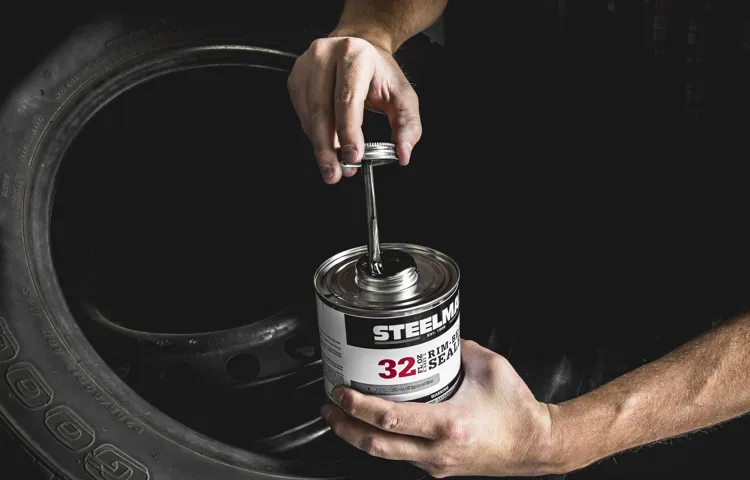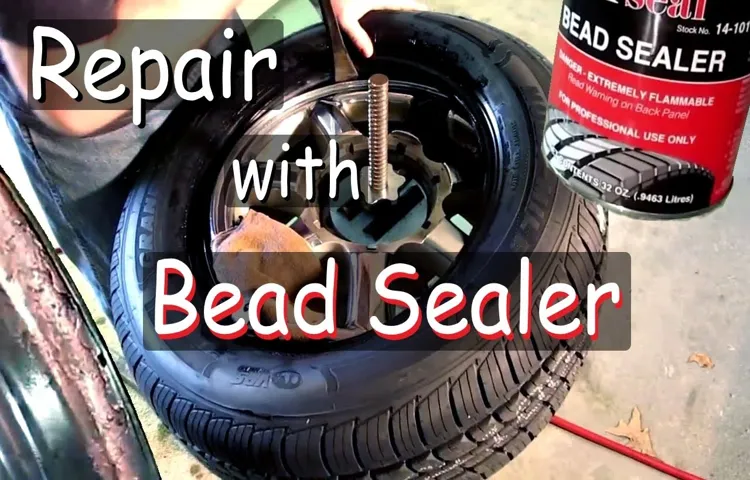Are you tired of continually inflating your tires due to bead leaks on the rim? Tire bead sealing may be the solution you’ve been searching for to avoid this frustrating problem. Properly sealing tires beads is crucial as it can determine the safe operation of your vehicle and save you money in the long run. In this blog post, we will discuss the importance of tire bead sealing, the signs of leaky beads, and how to fix them.
By the end, you’ll know precisely how to seal tire beads and have a safer ride. So, let’s dive into it!
Table of Contents
Introduction
If you have a leaking tire bead, you might wonder what can be used to seal it. One option is to use a tire sealant, which is a liquid that can be added to the tire to seal the leak. Another option is to use a tire bead sealer, which is a special glue-like substance that can be applied to the bead of the tire to create a tight seal between the tire and the rim.
Both of these options can be effective in sealing a tire bead, but it’s important to follow the manufacturer’s instructions carefully and to choose a product that is designed for your specific type of tire and rim. Keep in mind that while these solutions can work in many cases, if the damage to the tire or rim is severe, it may be safest to replace the tire or seek professional assistance.
Defining Tire Beads
Introduction Have you ever wondered what tire beads are? Well, you’ve come to the right place. Tire beads are a crucial component of any tire and play a significant role in ensuring that you have a safe and smooth driving experience. Simply put, tire beads are the part of the tire that holds it securely to the wheel.
The bead is the section that fits snugly onto the rim of the wheel, preventing the tire from slipping or coming off while driving. Without tire beads, the tire would not be able to maintain its shape properly or stay firmly attached to the wheel. The bead is made up of steel cords that are coated with rubber and wound into a hoop-like structure.
The tire’s internal pressure creates a seal between the bead and the wheel, which locks the tire in place, ensuring optimal performance and safety. In summary, tire beads are a critical component of any tire, providing a secure fit to the wheel, maintaining the tire’s shape, and ensuring a smooth and safe ride. So, the next time you’re driving, and your tires are keeping you safely on the road, remember to thank those little steel cords.

Why Beads Need Sealing
When it comes to creating beautiful beadwork, an essential step is sealing them properly. Beads need sealing because they are porous, meaning they can absorb moisture, dirt, oils, and other substances that can damage their appearance and longevity. Sealing beads protects them from these potential hazards, ensuring that they maintain their original luster and appeal.
It also helps to prevent the eventual discoloration, peeling, or cracking of the beads, which can happen over time without proper care. By taking the time to seal your beads, you can enjoy your jewelry or decorative pieces for years to come. So, whether you’re a professional bead artist or a casual hobbyist, don’t forget the importance of sealing your beads!
Best Practices for Sealing a Tire Bead
When it comes to sealing a tire bead, there are several best practices that can help ensure a secure and long-lasting seal. One option is to use a bead sealer, which is a product designed specifically for this purpose. Bead sealers are typically applied to the edge of the tire bead, where they help fill in any gaps or irregularities that might prevent a tight seal from forming.
Another option is to use a lubricant, such as soap and water or silicone spray, to help the tire bead slide into place more easily. This can be especially useful for stubborn or hard-to-fit tires. Regardless of which method you choose, it’s important to make sure that the tire bead is properly seated on the wheel and that the tire is inflated to the appropriate pressure.
With the right techniques and products, you can ensure a secure and safe seal for your vehicle’s tires.
Using a Tire Sealant
Tire Sealant If you’ve ever experienced a flat tire, you know just how frustrating and inconvenient it can be. That’s where tire sealant comes in handy. But did you know that sealing a tire bead requires some best practices to ensure it’s done correctly? First, make sure the tire is properly inflated before applying the sealant.
Then, remove the debris and clean the damaged area thoroughly. Next, insert the sealant into the tire, and re-inflate it to the manufacturer’s recommended pressure. Finally, drive the vehicle for a few miles to allow the sealant to spread evenly in the tire.
It’s important to note that sealant is a temporary fix and should be considered a short-term solution until you can get the tire repaired or replaced. So, while tire sealant can be a lifesaver in a pinch, it’s always best to have a spare tire on hand just in case.
Using a Bead Sealer
If you’re looking to fix a tire that just won’t seal and you’ve tried everything, using a bead sealer might be your best bet. Bead sealers are specifically designed to help tires with difficult-to-seal beads due to corroded or damaged rims. The best practice when using a bead sealer is to start by cleaning the bead seat and the bead itself before applying.
The sealer is applied by spraying it directly onto the bead seat and allowing it to dry completely. It’s important to ensure that the sealer is completely dry and tacky before reassembling the tire and rim. By using a bead sealer, you can help extend the life of your tires and prevent costly replacements.
So the next time you have trouble sealing a tire bead, give a bead sealer a try.
Using a Rubber Cement Type Solution
If you want to seal a tire bead, one of the most effective solutions is to use a rubber cement-type solution. This type of sealant is specially designed to adhere to the tire and rim surfaces, creating a strong bond that prevents air from escaping. Before applying the solution, make sure both the tire and rim surfaces are clean and dry.
Then, apply the sealant evenly along the bead area of the tire and the rim surface. While many people prefer using a brush to apply the sealant, you can also use your fingers or a rag. Once the sealant is applied, you need to let it dry for at least 24 hours before inflating the tire.
If you follow these steps carefully, you can ensure a long-lasting seal that will keep your tire inflated and safe for longer. So, if you’re dealing with a stubborn tire bead, try using a rubber cement-type solution to seal it effectively.
How to Seal a Tire Bead Step-by-Step
If you’re experiencing a leak from a tire bead, you may be wondering what you can use to seal it. The good news is that there are a few options available. First, you can try using a tire sealant product that is designed to specifically address bead leaks.
These products typically come in a can or bottle and are applied directly to the bead area. Another option is to use a tire bead sealer, which is a thicker substance that is typically applied with a brush. To seal the bead, you’ll need to first remove any dirt or debris from the area.
Then, apply the sealant or sealer according to the instructions, making sure to cover the entire bead thoroughly. Once you’ve applied the product, allow it to dry completely before inflating the tire. With the right product and careful application, you can effectively seal your tire bead and get back on the road safely.
Step 1: Cleaning and Inspection
When it comes to sealing a tire bead, the first step should always be cleaning and inspecting the area. This will ensure that the bead can be properly sealed and prevent any further damages to the tire. Begin by cleaning the bead area using soap and water to remove any dirt or debris.
It’s important to pay close attention to any portions of the bead that appear worn or damaged, as these areas may require additional attention. Once the area is clean, carefully inspect the tire for any damage or issues, such as cuts or punctures. If any problems are discovered, they should be addressed before attempting to seal the tire bead.
By taking these steps, you can help ensure a successful tire bead seal and maintain the overall safety of your vehicle on the road.
Step 2: Applying the Sealant/Sealer
Sealing a tire bead can be an essential step in fixing a flat tire or preventing slow leaks. Once you have cleaned the tire bead and rim, it’s time to apply the sealant or sealer. First, shake the bottle of sealant thoroughly before removing the cap.
Then, apply a small amount of sealant evenly around the tire bead. Make sure to coat the entire circumference of the bead with a thin layer of sealant. Next, carefully inflate the tire to the recommended pressure and let it sit for a few minutes.
This allows the sealant to spread and fill any gaps or imperfections in the bead. Finally, check the tire pressure and adjust as needed. Keep in mind that sealant should not be used as a permanent fix for a damaged tire, but rather as a temporary solution until the tire can be properly repaired or replaced.
Using a sealant can help extend the life of your tires and keep you safe on the road.
Step 3: Rechecking and Inflating the Tire
Sealing a tire bead can be a hassle, but it’s an important task to ensure a safe and secure drive. Once you’ve applied the tire sealant around the bead, it’s time to recheck and inflate the tire. First, examine the tire for any visible leaks or punctures.
If you find any, fix them before proceeding. Then, use a tire pressure gauge to check if the tire has the correct pressure level. If not, inflate it to the recommended level.
Next, add a bit of soapy water around the bead to check if there are any air leaks. If you see bubbles forming, this means that there’s still some air escaping from the tire. In this case, you’ll need to deflate the tire and reseat the bead again, using a tire bead seater tool to reinforce the seal.
Once you’re sure that the tire is fully sealed, inflate it to the correct pressure level again and give it a final check. By following these steps, you can ensure that your tire is fully sealed and ready for a safe and comfortable drive.
Conclusion
In conclusion, when it comes to sealing a tire bead, there are a variety of options at your disposal. From traditional methods like soap and water, to high-tech solutions like tire sealant, the choice ultimately depends on your needs and preferences. So next time you find yourself with a leaky tire, just remember: there’s more than one way to bead a seal.
“
Benefits of Proper Tire Bead Sealing
Proper tire bead sealing is vital to ensure that your vehicle’s tires function optimally and safely. A well-sealed tire bead enhances tire stability, reduces the likelihood of tire punctures, and enhances fuel efficiency. This makes it an essential step in tire maintenance that every car owner should familiarize themselves with.
In this step-by-step guide, we will show you how to seal a tire bead effectively. Begin by deflating your tire and removing it from the wheel. Thoroughly clean the rim.
Apply a coat of bead sealer onto the bead seat. Install the tire back onto the rim, ensuring that it’s well-seated. Reinflate the tire, and you’re done! A well-sealed tire bead saves you from unwanted expenses, ensures your car’s stability, and enhances your driving experience.
So, make sure to check your tire’s sealing regularly.
Maintaining Tire Safety
Maintaining Tire Safety, Seal a Tire Bead Maintaining tire safety is essential for any driver, and one of the most crucial aspects of tire maintenance is ensuring that the tire bead is sealed properly. A tire bead is a ring of steel wire that holds the tire tightly against the rim, creating an airtight seal. If the seal is not airtight, it can lead to air leakage, which can cause a dangerous situation while driving.
Here’s how you can seal a tire bead step-by-step: Step 1: Remove the Tire First, you will need to remove the tire from the rim. This is usually done by using a tire iron to pry the tire away from the rim. Step 2: Clean the Bead Once the tire is removed, use a wire brush to clean the bead area on the rim.
This will remove any dirt or debris that may prevent the bead from sealing correctly. Step 3: Apply Lubricant Apply a liberal amount of lubricant to the bead area on the rim. Lubricants such as vegetable oil or dish soap work well for this purpose.
Step 4: Reinstall the Tire Place the tire back onto the rim, making sure that the bead is lined up with the rim. Use a tire iron to push the bead over the rim and into place. Step 5: Inflate the Tire Inflate the tire to the recommended pressure and check for leaks.
If you notice any leaks, ensure that the tire bead is sealed correctly before driving. In summary, maintaining tire safety involves ensuring that the tire bead is sealed correctly. By following these simple steps, you can seal a tire bead properly and prevent air leakage while driving, reducing safety risks.
Remember always to consult with a professional if you are in doubt.
FAQs
What is a tire bead?
A tire bead is the part of a tire that sits on the rim of the wheel.
Why do tire beads need to be sealed?
Tire beads need to be sealed in order to maintain air pressure within the tire.
What happens if a tire bead is not properly sealed?
If a tire bead is not properly sealed, the tire may lose air pressure, which can lead to decreased fuel efficiency, poor handling, and increased risk of a blowout.
What can you use to seal a tire bead?
One common method to seal a tire bead is to use bead sealer, a rubber-based liquid that is applied between the tire bead and the rim.
How do you apply bead sealer to a tire bead?
To apply bead sealer, first remove any dirt or debris from the tire bead and rim. Then, apply the bead sealer evenly to the tire bead, ensuring that all areas are covered. After applying the bead sealer, allow it to dry for several minutes before inflating the tire.
Can you use anything besides bead sealer to seal a tire bead?
While bead sealer is the most common method to seal a tire bead, some people have had success using other materials such as silicone sealant or even duct tape. However, it is generally recommended to use bead sealer for the best results.
How often should tire beads be checked and resealed if necessary?
It is recommended to check tire beads for leaks every time the tires are rotated or replaced, and to reseal the beads if any leaks are detected. Additionally, if the vehicle is driven in rough conditions or off-road, it may be necessary to check and reseal the beads more frequently.



